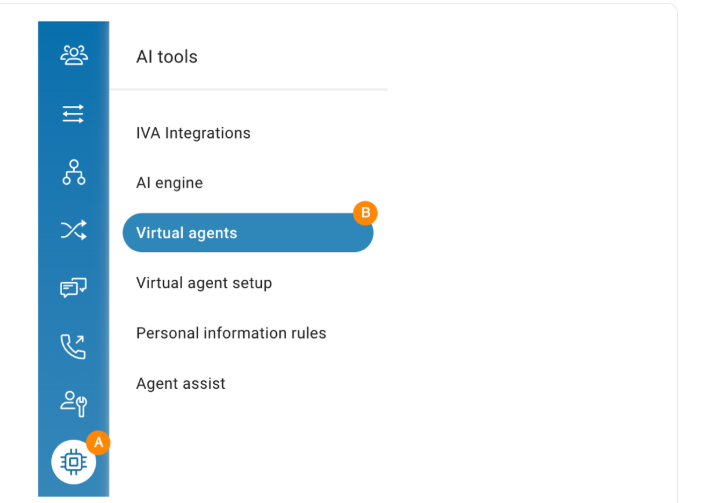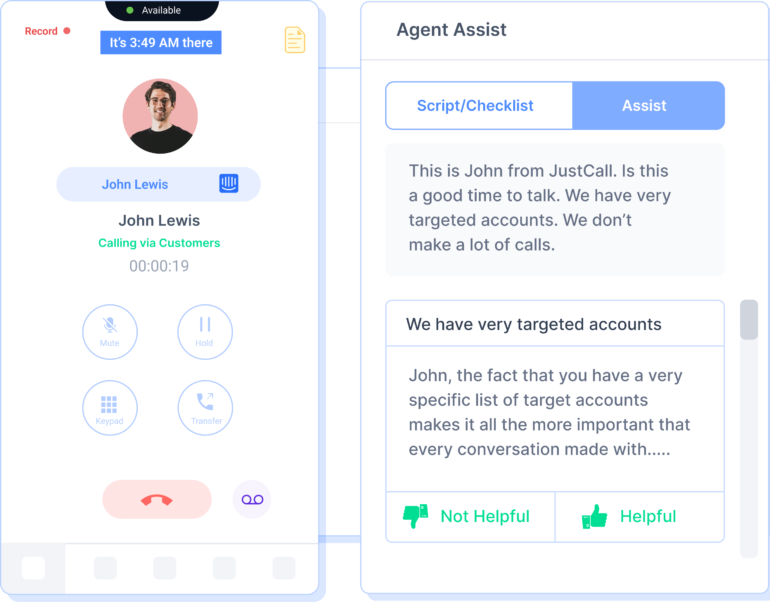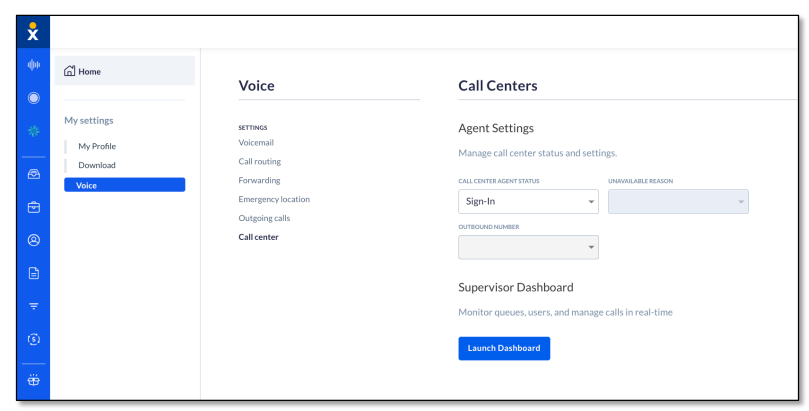Automating complex processes and repetitive tasks is my top tip for improving operational efficiency across various industries, including call centers. As someone who constantly seeks new ways to help streamline processes and adopt time-saving solutions, I believe that now is an ideal time to enhance your operations by implementing automation.
Although automation is not a new concept, the rise of artificial intelligence (AI) has significantly transformed the landscape. With that said, not every industry is just starting to adopt automation and artificial intelligence. Automation in call centers has been a crucial feature long before the rise of generative AI. This guide focuses on the numerous call center automation tools that have evolved over the years, as well as some useful tips that can elevate your business strategy to the next level.
Call center automation explained
Before we dive into the tips, it’s important to clarify some definitions and provide examples. Call center automation refers to the various methods and technologies utilized to streamline processes and simplify operations within a call center. This includes, but is not limited to, automating call answering, managing campaigns, and handling customer interactions.
While several technologies underpin the automation process, most automated call center tools employ a combination of machine learning and artificial intelligence. For example, AI is frequently used to enhance the interactivity of applications, as evident in the use of virtual agents and chatbots. Meanwhile, machine learning models play a crucial role in analyzing data, making predictions, and automating complex call flows and repetitive tasks.
Popular uses of call center automation
While there are many types of call center automation, it is best to focus on the most popular use cases for businesses that manage a team of agents and a constant influx of calls. Explore the following tabs to discover more about each automation tool and its benefits for call center agents, supervisors, and customers.
| Agents | Supervisors | Customers |
|---|---|---|
| One of the primary uses of call center automation is to enhance the efficiency of call center agents. Intelligent routing systems can automatically direct calls to specific agents based on their skills and availability. Additionally, features powered by AI, such as Agent Assist or Copilots, provide real-time support to agents by offering feedback, generating call notes and summaries, and transcribing conversations in real time. | Call center supervisors or administrators can manage automation features using performance dashboards that provide easy access to call data, such as agent performance and customer feedback. As a result, supervisors can benefit from workflow management and quality assurance monitoring, which automate the scheduling of agents and the oversight of calls. | Contact center automation tools that enhance customer experience enable self-service by allowing customers to interact with automated systems, such as interactive voice response (IVR), AI chatbots, and virtual agents. These systems are advantageous because they are available 24/7 and can provide immediate answers to simple inquiries across various channels, eliminating lengthy wait times and enhancing digital self-service. |
How call center automation works
While there isn’t just one way to approach call center automation, think of it as a process that starts with a triggering event, leading to other events through the use of specific technology. In my experience with call center tools, using a customer-first approach is key. So, I’ve gathered some tips on how to automate call center processes for agents, customers, and supervisors, which you can explore below.
Customers initiate the automation journey
In many cases, automated processes begin with customer interactions. When using an auto-receptionist or an interactive voice response (IVR) system, a customer call triggers an automated response from the phone system. This system interprets the customer’s speech or keypad selections from the call menu.
As the conversation unfolds, technologies like natural language processing (NLP) and automated speech recognition (ASR) work behind the scenes, deciphering the caller’s needs and preferences. This process is often guided by automatic call distribution (ACD), which not only directs the call to the right department or chatbot but can also notify specific agents based on the customer’s unique requirements.

If an agent isn’t available, callback automation allows customers to return to their day instead of waiting in a queue. Virtual agents can also step in to answer simple inquiries. Then, when the call routing is completed and a customer receives their resolution, automated surveys make it easy to gather feedback on the interaction to improve or applaud agent performance.
Agents maintain momentum with automation
At the same time that customers interact with call center automation tools, agents are also supported with agent assistance and copilots. Agents often juggle several tasks, such as gathering information from customers and addressing their concerns, so agent assistance tools make a big difference in the daily work of call center agents.

With the help of automation, tasks such as recording and transcribing calls, as well as creating post-call summaries, become significantly easier. This means agents can spend more time listening to their customers. Additionally, automated feedback, customer follow-ups, and post-call wrap-ups enable agents to better assist customers, improving key metrics such as first-call resolution (FCR) and customer satisfaction (CSAT).
Supervisors ensure successful outcomes
Throughout the call flow, supervisors can also utilize call center automation tools to support agents and customers behind the scenes. Call center software offers reporting and analytics dashboards, as well as access to call center monitoring and workforce management tools, enabling supervisors to automate and streamline workflows, including scheduling agents, evaluating calls, and tracking customer feedback.

Rather than manually selecting calls for evaluation, providing feedback to agents, or analyzing customer surveys, call center software employs AI to assist supervisors with these tasks. For example, workforce management tools monitor trends in call volumes to suggest when and how to schedule agents, while also offering predictive forecasting of call center trends.
Then, quality assurance software uses speech and text analytics on call recordings, and the transcriptions are automatically evaluated for specific topics or keywords to ensure that agents adhere to scripts and that customer interactions remain positive. This technology can also provide sentiment analysis of customer data to expedite the process of improving CSAT scores.
Five benefits of call center automation
When you make the most of the call center automation tools available to you, you can enjoy numerous benefits for your business. Explore the following list to discover all the positive changes that come with using these tools to their fullest potential:
- Improved customer experience (CX): Most software on the market advertises that it can help improve customer experience, but call center automation can truly assist you in this goal by speeding up the process of completing repetitive tasks, moving customers through the call flow journey, and getting calls resolved through automated routing and call management.
- Enhanced agent productivity: One of the primary concerns in call centers is the high turnover rate among agents, which can lead to burnout and productivity issues. However, by automating specific tasks, you can enhance productivity, allowing agents to focus on pacing themselves and improving customer service.
- Streamlined workflows: Managing a call center involves numerous components, so finding ways to enhance the efficiency of your system can lead to increased profits and productivity. By incorporating various types of software, such as quality monitoring, workforce management, and call distribution, you can establish clear workflows and processes that benefit your business.
- Reduced costs: For call centers with a small team of agents, resource management becomes even more crucial to the long-term success of your business. Automating tasks such as agent scheduling and incorporating virtual agents can help reduce costs associated with incorrectly allocating your resources over time.
- Scalability: Call centers frequently experience fluctuations in call volumes, requiring continuous adjustments to agent availability and operational processes. To effectively manage these fluctuations, automated tools can provide agents with additional assistance during peak call periods. These tools can also predict trends in advance and give recommendations to supervisors to optimize staffing and resource allocation.
Common challenges (and how to solve them)
While call center automation offers excellent benefits, it’s important to acknowledge that there are also common concerns associated with using new tools and technology. To assist, I have carefully curated a list of challenges in call center management, along with tips on how to address them.
Considering customer experience
Although many customers are accustomed to automated systems for routing calls, such as IVRs and IVAs, according to Five9’s 2025 Customer Experience Report, “Human connection is crucial, with 86% of respondents indicating it matters more than a quick response.” Therefore, instead of creating a call center full of virtual agents or implementing lengthy automated call flows, it is vital to consider the customer experience when utilizing these tools.
Especially if your call center is new to incorporating more automation or if you plan to make changes to automatic routing or other processes, you should monitor customer feedback to ensure that any changes you make are as beneficial to customers as they are to your business.
Integration with CRMs and business applications
Within many call centers, integrations with customer relationship management (CRM) software and other tools are essential for managing calls, as they enable agents and supervisors to access crucial customer information, including notes from previous interactions. However, not all call center software integrates with every CRM, and even if they do, that doesn’t mean the integration is seamless.
To support a successful integration with third-party applications and software, choose automation tools that are already compatible with your current call center software. Additionally, if you have multiple tools, consider choosing a platform that offers priority support and onboarding assistance to help with any data transfer issues.
Data privacy and security
Although many business owners get excited about implementing new technology in a workspace, as a data curation specialist, I always need to caution tech enthusiasts about the data privacy concerns that can accompany these tools. Especially with automation and AI, granting software access to your customer and call data without proper oversight can lead to problems down the line regarding what information is being collected, accessed, and shared.
Therefore, consider all the possibilities that come with adopting call center automation tools, as well as the data governance models and security compliance that are included in the software you choose. By keeping data privacy at the forefront of your mind, you can effectively mitigate the risks associated with automating workflows using AI or other tools.
Balancing employee concerns
As automation and artificial intelligence become more prevalent across various industries, employees often hold differing opinions regarding the adoption of these technologies. While some may wholeheartedly embrace new technology, others might perceive the introduction of virtual agents or automated processes as a threat to their jobs, viewing call monitoring software as yet another method of employee surveillance.
With that in mind, one of the most important aspects of adopting call center automation tools is providing multiple training sessions and feedback opportunities with agents and supervisors. This allows you to address any employee questions about the automation tools and how they can serve as collaborators rather than competitors in the workplace, such as agent and supervisor assistants.
Accuracy of artificial intelligence
Another challenge in automating processes such as call transcriptions and analysis is the accuracy of artificial intelligence in understanding human speech and behavior. While many AI tools can interpret speech, they are not always the most effective at it, so maintaining human oversight on these automated analyses is crucial.
As an AI model trainer, I have also found that training any AI models you use on your call data and industry vocabulary can help fine-tune your tools and provide more accurate analytics. By doing so, the model will become more familiar with the linguistic norms of your agents and customers, which makes it easier to understand commonly recurring topics and terms.
Four steps for successful call center automation
Now that you’re familiar with the key benefits and challenges of call center automation, let’s dive into some call center best practices that can help set you up for long-term success, with examples on how to apply each tip:
Step 1: Assess your business needs
Before taking any action, it is essential to consider what you want to achieve by implementing a specific tool, rather than adding more automation to your business without knowing why you need it. So, the first step is to review your call data, as well as agent and customer feedback, to gain a clear picture of the types of processes that may require improvement.
For example, if you receive customer feedback about long wait times or difficulty finding an agent to assist with their needs, you may need to update your automated call distribution system. However, if agents are struggling to conclude calls promptly, it might be a good opportunity to consider automated transcriptions and post-call summaries.
Step 2: Create clear goals
Once you have a clear view of your top priorities, the next step is to set goals. But not just any goals. You need to set goals that are clear, measurable, and trackable, using call center reporting tools. Call center reports often collect data on call volume, agent availability, and customer satisfaction, among other key metrics.
By creating clear goals and objectives, you can ensure that any changes made within your call center to automate specific processes are linked to a specific goal and outcome. For example, if you have decided to automate post-call work for agents, you should track the time it takes agents to complete after-call work (ACW) to identify areas for improvement.
Step 3: Find the right tools
Depending on the changes you plan to make in call center automation and the metrics you want to track, select tools that align with your goals. So, if you know that improving agent productivity is what you plan to achieve by automating wrap-up work, then you should find a provider that offers agent assistance or automated post-call summaries.
Additionally, it is crucial to consider whether you can integrate these tools into your current phone system or if you will need a new subscription or provider to achieve your goals. If your current provider doesn’t have what you need, also remember to check the integration capabilities of your software to find tools that are compatible with it.
Step 4: Develop a plan
After identifying your goals and the tools to achieve them, create an implementation plan. This plan not only outlines how you intend to utilize your call center automation software but also how you plan to track key metrics and the timelines for measuring progress toward your goals.
While we often hope for quick results from adopting a new process or tool, it’s best to track your growth over one or two quarters to determine whether your implementation is successful. As you transition to more automated workflows, remember that change is an iterative process. Continue gathering feedback and analyzing data, and ensure that employees receive training on how to adapt to any changes in the workflow.
Choosing the right call center automation tools
In the previous section, I provided guidance on best practices, offering a brief overview of selecting the right tool for your business goals. In this section, I included more context on choosing the best call center automation tools. Check out the chart below to explore specific use cases for these tools and the call and contact center providers that offer them.
| Best use cases | Call and contact center automation tools | Providers offering this tool |
|---|---|---|
| If you need, call routing, choose: |
|
|
| If you need customer self-service, choose: |
|
|
| If you need agent assistance, choose: |
|
|
| If you need employee management, choose: |
|
|
| If you need quality assurance, choose: |
|
|
Frequently asked questions (FAQs)
What is an automated call center?
Call center automation uses technologies, such as artificial intelligence, to accomplish repetitive tasks and free up agents’ time, so they can focus on more critical tasks. For example, call center automation can assist with routing calls and follow-up with customers when agents or supervisors are occupied with other tasks.
How does AI enhance call center automation?
Artificial intelligence enhances call center automation by providing specialized tools, such as AI chatbots and virtual agents, that deliver additional support and round-the-clock availability to customers. Moreover, machine learning models learn from your data, enabling predictive forecasting and effective management of fluctuating call volumes.
What should businesses consider before implementing call center automation?
Before implementing call center automation, businesses should start with a clear strategy that addresses their specific needs and outlines how success will be measured. Once this strategy is in place, it’s important to train agents on the new processes within the call center. Afterward, continue with periods of data evaluation and analysis to ensure that the new automated processes are genuinely enhancing your business operations.
Bottom line
Whether you’re exploring call center automation for the first time or seeking the latest tools to improve your existing software, I hope this guide has provided you with valuable insights and resources to successfully navigate the exciting journey of implementing call center automation.
Innovations such as AI chatbots and virtual agents have emerged, especially in AI call centers. These tools enhance agent support and improve customer experience by reducing costs and increasing agent availability. To stay ahead of the curve, be sure to keep track of new and emerging AI solutions that can enhance your call center operations.

